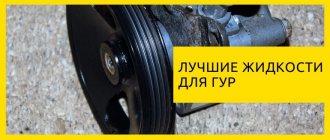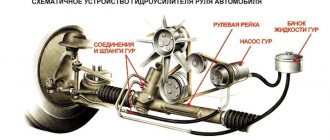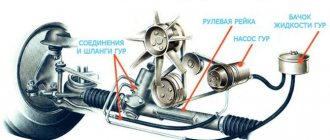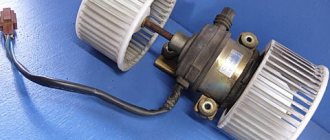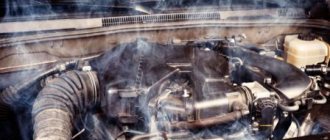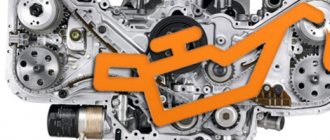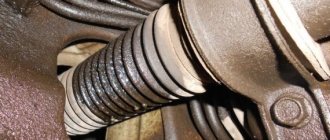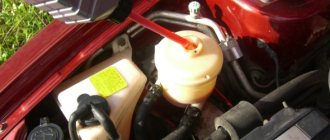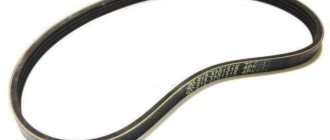If you find an error in the text, highlight it with the mouse and press Ctrl+Enter. Thank you.
Malfunctions of the power steering can lead to irreparable consequences, because driving a car, especially over long distances, is quite tiring, and the driver’s fatigue directly affects the increase in the likelihood of the car flying into a ditch or another accident.
Therefore, in order to alleviate the driver’s plight and reduce the likelihood of an accident, modern passenger cars are very often equipped with power steering. Initially, amplifiers were used only on trucks, but over time they also appeared on passenger cars.
The vehicle can be equipped with hydraulic, electro-hydraulic and electric power steering.
The most common are hydraulic boosters. Their design is not very complicated, but still, during the operation of the car, breakdowns of this steering unit may occur.
Malfunctions of the power steering can manifest themselves in the form of:
- Increased noise under the hood;
- Increased effort on the steering wheel;
- Leakage of working fluid.
Increased noise
Increased noise occurs in several cases. The appearance of extraneous sounds under the hood while turning the steering wheel most often indicates a loosening of the tension in the power steering pump drive belt.
To eliminate this problem, you need to check the belt tension. In working condition, with increased pressure on the belt with your thumb, it should bend by 0.1-0.15 cm. If the belt bends much more, it should be tightened with a tensioning mechanism.
Increased noise may be due to the fact that there is not enough fluid in the system, resulting in air getting into it. In this case, you need to add the recommended fluid to the power steering reservoir. But after this, you should definitely bleed the system to remove air from it.
This operation can be performed differently on different cars.
Air in the power steering system symptoms
Hi all! In winter and spring I tinkered with the air intake in the power steering system. The power steering pump squealed during a cold start. I changed the gasket repair kit in the power steering pump. I hung additional clamps on the hoses of the power steering reservoir.
Then I blew a car compressor into the power steering reservoir at 1-1.5 bar and noticed how the power steering pressure sensor was snotty.
But over the last couple of months, the squealing has returned, and it did not subside even when the engine was warm. There were actually bubbles in the power steering reservoir right during operation. Removing air from the system (turning the steering wheel back and forth until it stops with the engine off) did not help.
If there is a special fitting
In one case, bleeding is carried out using a special fitting, which can be found on the power steering housing. To make pumping easier, the front part of the car is hung up, the steering wheel is turned in any direction until it stops. In this case, the engine must be turned off.
Then the bleeder fitting is loosened a little so that air can escape through it. After this, the steering wheel does not quickly turn in the other direction until it stops.
When turning the steering wheel, all air from the system should escape through the fitting. A signal that air has escaped will be the appearance of liquid from the fitting. If the fluid has leaked, then, without changing the position of the steering wheel, the fitting must be tightened so that air does not get back into the system through it. When carrying out this operation, you need to constantly monitor the liquid level in the tank.
Then you should lower the front of the car. To complete bleeding the system, you need to start the engine and start turning the steering wheel from side to side until it stops. But you cannot hold the steering wheel in the extreme position for a long time.
During this operation, air bubbles will appear in the tank. You need to turn the steering wheel with the engine running until these bubbles disappear.
Hydraulic booster without fitting
If the hydraulic booster is not equipped with a fitting for bleeding air, the pumping process is performed slightly differently. Initially, operations are carried out with the engine turned off. To do this, the front of the car is hung out. Liquid is poured into the tank to the level. Then you need to turn the steering wheel from lock to lock several times.
Then the car lowers to the ground. Then you will need to start the engine and let it run for a few minutes. Next, the steering wheel must be turned again from the stop, first to the left, then to the right, without stopping in the extreme positions. In this case, you need to monitor the liquid level and top up if necessary.
During this operation, foam forms on the surface of the liquid in the tank. Then you need to stop the engine and wait until the foam disappears. The pumping has been completed.
If you constantly hear noise under the hood, this indicates wear on the bearings of the power steering pump. In this case, the pump is replaced.
Is it worth pumping yourself?
The question is purely individual. It depends on your skills, capabilities and desire to save. The cost of the working fluid itself for power steering depends on many parameters, and therefore prices vary from 4 to 15 dollars per 1 liter. In total, pumping and replacement will require from 1 to 3 liters.
When you contact a car service center, they will charge you at least 1,000 rubles for pumping work. The replacement procedure costs about 2000 rubles. Now decide for yourself whether it’s worth spending money on this, or take everything into your own hands and solve the issue yourself.
Bleeding the power steering cannot be called difficult. Many inexperienced car owners easily perform this work. It is only important to follow the manufacturer's recommendations and use high-quality fluid suitable for your specific power steering.
Thank you all for your attention! Subscribe to our website, ask questions and tell your friends about us!
Source
Leakage of working fluid
Very often, power steering malfunctions come down to leakage of working fluid. It can leak in places where pipelines are attached or in case of damage to these pipelines.
In the first case, it is recommended to replace the clamps on the pipelines. If the pipeline is damaged, it must be replaced, which will require draining the working fluid from the system. Moreover, it is advisable to change all pipelines at once. After replacing the pipelines, new fluid is poured into the system and pumping is carried out.
It is important to remember that reusing power steering fluid is not recommended, as this can lead to failure of power steering components.
If there is a video in the article and it does not play, select any word with the mouse, press Ctrl+Enter, enter any word in the window that appears and click “SEND”. Thank you.
· July 31, 2016
Most motorists are faced with such an unpleasant situation as depressurization of the hydraulic power steering.
As a rule, the “symptom” of this problem is a characteristic unpleasant sound coming from under the hood of the car. Most often there is air in the power steering
is formed due to improper maintenance or due to worn-out high-pressure pipes in the power steering system.
First of all, it is necessary to determine the cause of the depressurization and, if necessary, replace the faulty elements.
After which you should pay attention to the quality of the working fluid: the oil should not have any foreign impurities or small objects.
This procedure is easy to carry out at home, since any unnecessary objects are visible to the naked eye. The working fluid of the power steering system must be clean and transparent. If there are cloudy spots in the oil, then it needs to be replaced with a new one.
After all the above steps have been completed, you can proceed directly to the next stage - how to bleed the power steering.
How to pump power steering
How to fill oil and bleed power steering
The procedure for replacing fluid and pumping power steering is carried out in strict accordance with the existing algorithm. Some automakers may add their own features to it. If you have a manual for your car, we recommend that you read the relevant section. In general terms, the steps must be performed in the following sequence:
Pumping out oil with a syringe
How to bleed air from power steering
Quite often, air gets into the power steering precisely during the process of changing the working fluid. To avoid this problem, oil must be poured into the hydraulic system slowly (5-6 liters per minute).
Thanks to this fill, air will not be sucked into the power steering mechanism. But, if during the process of changing the working fluid, floating bubbles are visible or the oil foams, then in this case, it is necessary to leave the system open for 30-40 minutes to de-air.
To prevent air from entering the power steering, automotive service specialists advise pouring the working mixture into the tank not to the mark on the neck, but to the very edge. After which, within 10-15 minutes, the oil level will begin to drop. The refilling process should be carried out until the fluid level stabilizes.
Now that the front beam is raised, you need to turn the steering wheel as far as possible to the right, and find and open a special bleeder fitting on the hydraulic system housing. It is strictly forbidden to perform these operations while the engine is running.
Working fluid should begin to flow out of the open fitting, and only after it stops foaming and begins to flow in a smooth, clean stream, it is necessary to turn the steering wheel all the way to the left and do the same manipulations.
When the system is completely vented, it is necessary to close the bleeder fitting and leave the steering wheel in the same position.
Then you need to add the missing amount of oil into the neck of the tank. Now that all the points have been completed, you should again check the power steering system for air pockets by turning the steering wheel from side to side.
If, when you turn the steering wheel, you don’t hear any squeaking sounds from under the hood, then everything is done correctly.
When cars are used for a long time in harsh Russian conditions, they often develop very specific problems. A sign of one of them is the appearance of foam in the power steering reservoir. This symptom is often ignored by many motorists, doing so completely in vain - after all, a malfunction can be deadly. The owner of the car must know why it foams and what to do if such a problem occurs.
How to bleed the power steering with your own hands: simple instructions
Hi all! The article was created specifically for owners of cars with power steering and those who plan to make a corresponding purchase in the future. We’ll talk to you about how to bleed the power steering, what is required for this and whether it is possible to do the work yourself.
Practice clearly shows that pumping is done in cases where the working fluid is being replaced, when signs of air congestion and malfunctions are detected. Typically, such a need arises as a result of breakdowns or after standard repair work affecting the power steering system. For example, bleeding is often carried out after replacing the rack.
If you do not expel the air that has entered the system, this will lead to a decrease in the efficiency of the hydraulic booster and provoke further malfunctions. In particular, you may encounter the fact that the pump will need to be replaced, and there will be no way to restore it.
- on KAMAZ;
- on Shakman;
- ZIL 130;
- on the Volga (GAZ 31105);
- in Scania;
- Toyota Corolla;
- Nissan Qashqai;
- Lada Priora;
- Renault Symbol;
- Ford Focus;
- Niva Chevrolet;
- Volkswagen Passat B3;
- Toyota Avensis;
- Skoda Octavia;
- Renault Logan, etc.
The automotive power steering system can become airy for reasons already stated, related to breakdowns, or structural interference in the power steering.
However, there are exceptions when automakers adjust the pumping process, trying to make it more convenient and simpler. With the instruction manual at hand, be sure to look at the correct section. There you will find everything you need related to the hydraulic booster installed specifically on your vehicle. Due to the introduction of some features of each car manufacturer and power steering systems, a universal pumping scheme cannot actually exist. There are several common points that are characteristic of all hydraulic boosters.
It is on them that I propose to place the main emphasis. This will give you the opportunity to understand what to do and what to build on when planning to bleed the power steering on your own car.
Initially, you will need appropriate conditions where you can lift the car completely or hang the front wheels. If necessary, the old fluid is drained from the expansion tank. To do this, remove the return hose from the tank and insert a plug into it. This will prevent hydraulic fluid from spilling out.
Having released one of the taps on the tank, a hose connected to an empty plastic bottle is connected to it. It is there that the hydraulic mixture from the power steering system will subsequently be drained. This is the simplest and most common scheme.
To make it easier for you to pump out the bulk of the old fluid, you can use a syringe. As soon as a minimum volume of hydraulics remains in the reservoir, which can no longer be pumped out with this device, you can move on to the next stage. Namely, fill in new fluid to the upper mark on the expansion tank. After this, be sure to turn the front wheels in different directions and strictly until they stop. This will allow any remaining old fluid to drain out through the connected hose.
Please note that the new hydraulic oil will now displace the old one. Monitor the level carefully and try not to allow air to enter the system through the hose.
Further actions
We have already managed to cover about half the distance together. As you can see, nothing complicated yet. Everything can be done with your own hands, without having any special skills or deep knowledge.
After completing all the previous steps, follow these steps:
- if the liquid level in the expansion tank has dropped, add oil;
- start the engine for literally 3 seconds and turn it off;
- the liquid will begin to spread throughout the system;
- add oil to the MAX mark and repeat the procedure with the internal combustion engine;
- such a cycle usually requires 3-5 repetitions;
- you need to stop pumping when air stops escaping into the drain bottle;
- if clean hydraulics without bubbles enter the container, there is no air left in the system;
- return the return hose to its place;
- if necessary, add oil to the maximum mark;
- start the engine;
- slowly turn the steering wheel left and right until it stops 4-5 times;
- Having turned the steering wheel all the way, stop for 2-3 seconds and turn in the opposite direction;
- if there is remaining air, it will enter the expansion tank;
- Make sure that the power steering pump does not create any extraneous noise when pumping;
- as soon as air bubbles stop appearing on the surface of the power steering fluid in the tank, pumping is completed;
- Screw the reservoir cap tightly.
Causes and consequences
The most common reason for the appearance of foam in oil is the penetration of air into the technical fluid. It can be pumped into the hydraulic system when the engine is running without a power steering reservoir cap or when the integrity of the circuit is damaged. Air often gets into the power steering oil through cracks in the hoses and pipes, which may not leak - it will be quite difficult to detect them.
Air that has entered the closed hydraulic circuit completely changes the characteristics of the drive. As a result, the steering wheel may twitch when turning, and the force during its movement may vary, preventing the driver from accurately performing the intended maneuver. The most dangerous is steering wheel lock, which makes the car completely uncontrollable. The greatest danger is that the steering wheel usually locks when it is turned to its extreme position - that is, when performing very difficult maneuvers. The presence of air in the power steering circuit can be deadly, which every driver should be aware of!
There is another reason why oil foams in the power steering - it is represented by the ingress of foreign impurities into the liquid, which form a thick, stable foam when passing through the working area of the hydraulic booster. This can also result in poor handling and steering wheel locking, so the car owner should take immediate action. However, in this case you will need oil in the power steering.
Causes
Air entry
The most common cause of foam in the system is air in the power steering. Air can enter the hydraulic system through cracks in the hoses, when the plug on the fluid reservoir is open, when the seal of the entire system is broken, or when there are cracks in the pipe. The most difficult thing to identify is a crack in the hose, because it may be too thin and narrow, which means that liquid will not flow out. You will have to look at all the details carefully.
Air that enters the hydraulic system significantly changes the characteristics of the system unit. In other words, instead of turning the steering wheel smoothly and easily, you will definitely notice sharp twitches at the moment of turning. Moreover, each time you have to apply different amounts of force, which is why it is not always possible to perform the intended maneuver.
However, the most dangerous consequence caused by the appearance of foam is a sudden blocking of the steering rack. Imagine a situation, you are about to make a turn on a busy roadway, suddenly the steering wheel jams and you stop without the ability to quickly remove your vehicle from the road. It is worth remembering that air entering the power steering system can be fatal, and removing air from the power steering is a labor-intensive and time-consuming process.
Liquid ingress
Foam can also occur when another liquid or impurity gets into the working fluid. As a result, a chemical reaction of the working fluid to another composition occurs, a persistent foam is formed, which prevents the normal passage of fluid in the system. This reason is not an exception to increased danger; poor handling and steering rack wedge are a consequence of the problem.
The appearance of dirt in the hydraulic system
There can be several sources of dirt in a closed power steering system.
- One of them is a torn hose. In this case, you will notice a lack of fluid in the system when checking.
- The filter in the tank could become clogged, causing the liquid to no longer be filtered and dirt clogging the system components and preventing the passage of liquid.
- The fittings on the car's wheels may be clogged. This problem is the most problematic to fix, because you have to remove the wheels from the car to get to the fittings.
Troubleshooting
First of all, it is necessary to find the reason for air getting into the technical fluid. With the engine running, ask an assistant to move the steering wheel left and right and look carefully to see if bubbles appear on the rubber hoses. If there are no external signs, carefully inspect all pipes, connections and the surface of the oil reservoir for damage. All worn parts of the circuit should be replaced. If no breakdown was found, you should contact a specialist, since his services will cost less than replacing all components of the hydraulic system.
If the volume of air in the hydraulic booster is small, you can try to squeeze it out without disassembling the circuit. Start the car and let it idle for 3-5 minutes. After this, turn the steering wheel all the way to the right, wait 10-15 seconds and then repeat the procedure by selecting the steering wheel to the far left position. After several attempts, the air should come out of the hydraulic booster - this will be indicated by the absence of foam in the oil. Also, a method of quality control of repairs can be checking the volume of fluid in the tank - the difference in levels when the engine is running and when the car has completely cooled down should not exceed 5 mm.
Experts who know how to remove air from a hydraulic booster can tell you that in this way it is not always possible to restore the unit’s functionality. If after the first attempt the oil continues to foam, it is necessary to disconnect the return hose from the tank and close its hole with a special plug or an improvised stopper made of waterproof material. The end of the disconnected hose must be lowered into a clean bottle or other container.
To squeeze air out of the power steering, start the engine and turn the steering wheel until fluid starts coming out of the hose. After this, turn off the engine and pour the liquid back into the tank. The procedure is repeated until clean, bubble-free oil comes out of the hose. It is better to carry out such work together, since monitoring the presence of foam in the drained oil and stopping the engine in time on your own will be very problematic.
Sometimes the cause of foam may be dirt in the hydraulic circuit. Its sources most often are:
- Ruptures in hoses;
- in the tank;
- Clogged fittings on car wheels.
Changing a filter or a torn hose is not difficult. But it will be much more difficult to clean the fittings - to do this, you need to remove the wheels of the car and unscrew the protective cap with a 8mm wrench.
A hose with a diameter of 6.5 mm is connected to the fitting, after which oil from the hydraulic circuit is drained through it. It is very important to simultaneously add technical fluid to the power steering reservoir so that its level does not fall below the minimum allowable level. The operation is considered complete when clean oil without impurities and foam begins to flow through the hydraulic booster fitting. After completing the repair procedure, you should bleed the hydraulic circuit of the power steering. To do this, with the engine running, the steering wheel should be turned to its extreme positions, as described above.
Problem solving
Getting rid of air in the system
Now we will take a closer look at several ways to remove air from the power steering. First of all, inspect the system for damage; if none are detected with the naked eye, we will change the search method. You need to ask a friend to help. Turn on the car engine and ask your friend to move the steering wheel from side to side. Bubbles may have appeared on the rubber tubes or pipes. If you find such a place, then this part needs to be replaced with a new one.
Serious damage
Despite the apparent insignificance of such a defect, the appearance of foam in the power steering oil can lead to a serious accident. Therefore, such a breakdown should be repaired immediately, making every effort to do the job well. You should be very careful and carefully monitor the performance of the power steering system after the repair is completed. Practice shows that it is possible to completely squeeze out the air and eliminate all impurities in only one out of four cases. Therefore, if the hydraulic booster breaks down, delivering the car to a service station will not be superfluous at all, since we are talking about your safety.
Power steering is one of the main systems of the mechanism that sets the direction of movement. Its purpose is to facilitate vehicle control and ensure a stable position on the road.
Power steering system - device
After the steering wheel stops rotating, the spool stops. The drain line opens and the rotation of the wheels also stops. Thus, the main function of the hydraulic booster is to create comfortable driving conditions and increase safety, since the driver is able to drive even if the front tire breaks or the amplifier fails. In addition, power steering reduces the steering ratio, which accordingly allows for better maneuvering; it also reduces impacts on the steering wheel from the road and driver fatigue.
Why might the power steering act up?
Bleeding the power steering system is necessary to remove air from the system when there is increased noise under the hood. You should pay attention to this feature: if the car hits an obstacle, then the wheels experience resistance, which tends to turn them around. The wheels close the drain line, and the working fluid moves into the cylinder. The piston enhances the action of the wheels working in reverse. In this case, the system prevents the wheels from turning. If the pump is turned off, the driver will feel the steering wheel become heavier, but the car can be driven even in this case.
The power steering system may show the following signs of malfunction: loud noise under the hood, increased pressure on the steering wheel, fluid leakage
. Increased noise may occur due to the presence of air in the system; the situation requires bleeding. It is necessary to bleed the power steering system when air gets into it during repairs or depressurization. This happens when the steering wheel jams (sharp turns, the pump makes noise when turning, the liquid is foamy). We suggest performing this operation yourself, let's think about how!
How to bleed the power steering with your own hands: simple instructions
Hi all! The article was created specifically for owners of cars with power steering and those who plan to make a corresponding purchase in the future. We’ll talk to you about how to bleed the power steering, what is required for this and whether it is possible to do the work yourself.
Practice clearly shows that pumping is done in cases where the working fluid is being replaced, when signs of air congestion and malfunctions are detected. Typically, such a need arises as a result of breakdowns or after standard repair work affecting the power steering system. For example, bleeding is often carried out after replacing the rack.
If you do not expel the air that has entered the system, this will lead to a decrease in the efficiency of the hydraulic booster and provoke further malfunctions. In particular, you may encounter the fact that the pump will need to be replaced, and there will be no way to restore it.
- on KAMAZ;
- on Shakman;
- ZIL 130;
- on the Volga (GAZ 31105);
- in Scania;
- Toyota Corolla;
- Nissan Qashqai;
- Lada Priora;
- Renault Symbol;
- Ford Focus;
- Niva Chevrolet;
- Volkswagen Passat B3;
- Toyota Avensis;
- Skoda Octavia;
- Renault Logan, etc.
The automotive power steering system can become airy for reasons already stated, related to breakdowns, or structural interference in the power steering.
However, there are exceptions when automakers adjust the pumping process, trying to make it more convenient and simpler. With the instruction manual at hand, be sure to look at the correct section. There you will find everything you need related to the hydraulic booster installed specifically on your vehicle. Due to the introduction of some features of each car manufacturer and power steering systems, a universal pumping scheme cannot actually exist. There are several common points that are characteristic of all hydraulic boosters.
It is on them that I propose to place the main emphasis. This will give you the opportunity to understand what to do and what to build on when planning to bleed the power steering on your own car.
Initially, you will need appropriate conditions where you can lift the car completely or hang the front wheels. If necessary, the old fluid is drained from the expansion tank. To do this, remove the return hose from the tank and insert a plug into it. This will prevent hydraulic fluid from spilling out.
Bleeding the power steering system - we do it ourselves
Pumping occurs as follows. Place the wheel in the middle (direction) position and turn on the motor for 15 seconds. Now turn the steering wheel a couple of times until it stops. Remove the protective cap and unscrew the valve. If the fluid level drops, add it again and start the engine. The fluid level should drop, but do not let it drop below about. The machine should run idle for a minute. We lower the car if it was in a suspended state and turn the steering wheel all the way for 2-3 seconds. We turn off the engine and wait for the foam to disappear, and then start the engine again and check the sound.
Bleeding can also be carried out with a special fitting. It is located on the power steering housing. We hang the front wheels, turn the steering wheel all the way with the engine off. Then we loosen the fitting a little, allowing the air to escape, and turn the wheel in the other direction. Liquid should appear from the fitting; when it comes out, you need to close the fitting and monitor the liquid level. Now lower the front wheels to their previous position, start the engine and turn the steering wheel from side to side. This exercise should be done until the bubbles of expelled air in the tank disappear.
If you hear a sharp cutting sound from under the hood, then most likely there is a problem with the power steering. In most cases, such a malfunction occurs due to an air lock that forms in the system. Fortunately, with the help of pumping it can be eliminated and normal operation can be resumed.
Typical power steering malfunctions
Malfunctions in the operation of the hydraulic booster can be easily identified by characteristic signs. Among them:
- The steering wheel turns hard . Probable causes are failure of the power steering pump, use of unsuitable working fluid, sticking of the spool mechanism channels.
- , a high-frequency sound (similar to a whistle) is heard while driving The probable cause is a loose drive belt.
- The steering wheel turns jerkily . Probable causes of the malfunction are the working fluid not meeting the specifications declared by the manufacturer, a malfunction of the fluid distributing mechanism, or a pump malfunction.
- The presence of intense foaming in the expansion tank. Probable causes are mixing of different types of fluids, failure of the power steering pump.
- When the engine is running, the steering wheel spontaneously turns in any direction . The probable cause is malfunction of the spool mechanism, most often, clogging of its working channels, incorrect assembly (for example, after installing a repair kit).
Recommendations for operation and maintenance of power steering
In order for the power steering and its system to operate normally, as well as to extend their service life, you must adhere to several simple rules:
- use working fluids recommended by the automaker , and also replace them in a timely manner (most automakers recommend replacing power steering fluid every 60.120 thousand kilometers, or once every 2 years, it depends on the driving style and intensity of use of the car);
- carry out bleeding of the power steering system in strict accordance with the algorithm described above (or observing individual requirements, if any are set by the car manufacturer);
- monitor the condition of the steering rack boot , because if it is torn, dust and dirt will enter the system, which leads to the power steering pump exiting. A sign of a problem that has already occurred is the hum of the power steering, which is not eliminated even by replacing the fluid.
Cost of replacing fluid and pumping power steering
If you plan to carry out work on replacing the fluid and pumping the power steering yourself, then you will only need to buy oil in a volume of 1 to 3 liters (including flushing, while the volume of the power steering system of a passenger car is up to 1 liter). The price of the liquid depends on the brand and store. It is within $4.15 per liter. If you do not want or cannot carry out such work yourself, contact a service station for help. Approximate prices for January 2021 are:
- fluid replacement work - 1200 rubles;
- power steering pumping - 600 rubles.


